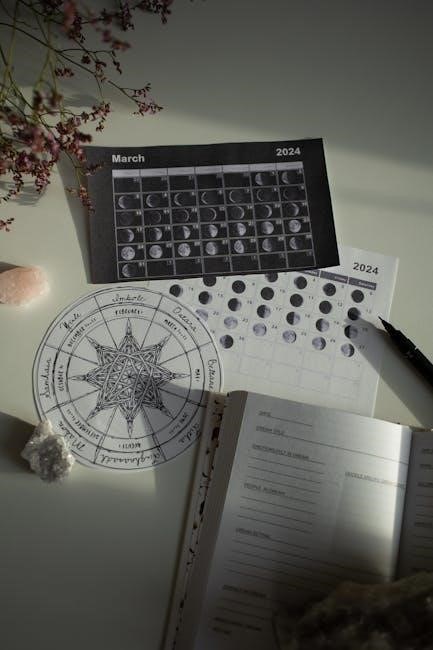The 2024 Liturgical Calendar provides a structured guide for worship, outlining key seasons, feast days, and liturgical colors․ Available as a printable PDF, it helps plan services and personal devotion, featuring traditional colors and essential dates like Advent beginning December 3, 2023, and Easter on March 31, 2024․
1․1 Overview of the Liturgical Year
The 2024 Liturgical Year begins on December 3, 2023, with the First Sunday of Advent․ It is divided into seasons: Advent, Christmas, Lent, Easter, and Ordinary Time․ Each season reflects a unique aspect of the faith journey, marked by specific liturgical colors and traditions․ A printable PDF version of the calendar is available, offering a structured guide for worship planning and personal devotion․ It includes key dates, such as the Solemnity of Mary on January 1, 2024, and Easter on March 31, 2024, helping followers stay connected to sacred rhythms and celebrations throughout the year․
1;2 Importance of the Liturgical Calendar in Worship
The Liturgical Calendar is a vital tool for guiding worship, fostering community, and deepening spiritual connection․ It structures the year around sacred seasons, feast days, and memorials, ensuring a balanced and meaningful expression of faith․ The calendar’s rhythms and colors help communities focus on key theological themes, while its digital versions, such as printable PDFs, offer practical resources for planning services and personal devotion․ By following the liturgical year, believers are united in worship and reminded of the Church’s rich traditions and spiritual heritage․

Liturgical Seasons in 2024
The 2024 Liturgical Calendar includes Advent (December 3, 2023), Christmas (December 25, 2023), Lent (2024), and Easter (March 31, 2024), guiding worship through sacred seasons․
2․1 Advent 2023-2024
Advent 2023-2024 begins on December 3, 2023, marking the start of the liturgical year․ It is a season of preparation and anticipation, lasting four Sundays before Christmas․ This period focuses on spiritual reflection, hope, and renewal․ Purple vestments and candles symbolize penance and royalty, honoring the coming of Christ․ Advent calendars and wreaths are popular traditions to count down the days until Christmas․ This season reminds believers to ready their hearts for the birth of Jesus and the second coming․ Its themes of expectation and joy set the tone for the Christmas celebration․
2․2 Christmas Season 2023-2024
The Christmas Season 2023-2024 begins on December 25, 2023, and concludes with the Feast of the Baptism of the Lord in January 2024․ This joyful period celebrates the Nativity of Jesus Christ, emphasizing the incarnation and God’s love․ Key events include the Octave of Christmas, the Holy Family Sunday, and the Epiphany․ White and gold vestments symbolize purity and celestial glory․ Traditions like Midnight Mass, carol singing, and the Nativity scene enrich the season’s spiritual and festive atmosphere, fostering reflection on redemption and divine love․
2․3 Lent 2024
Lent 2024 begins on Ash Wednesday, February 14, 2024, and concludes on March 30, 2024, with Palm Sunday․ This 40-day period excludes Sundays and focuses on spiritual preparation for Easter․ Purple vestments symbolize penance and royalty․ Key events include Ash Wednesday, when ashes are blessed, and Palm Sunday, marking Jesus’ triumphal entry into Jerusalem․ Practices such as prayer, fasting, and almsgiving emphasize spiritual renewal and reflection, guiding believers toward Easter’s resurrection joy․
2․4 Easter Season 2024
Easter Season 2024 begins on March 31, 2024, with Easter Sunday, and concludes on May 19, 2024, with Pentecost․ This 50-day period celebrates the resurrection of Jesus and the outpouring of the Holy Spirit․ White vestments symbolize joy and victory․ Key events include the Easter Vigil, Divine Mercy Sunday, and the Ascension of the Lord․ The season emphasizes renewal, hope, and the triumph of life over death, inviting believers to deepen their faith and spiritual practices in the light of Christ’s resurrection․
2․5 Ordinary Time 2024
Ordinary Time 2024 consists of two periods: January 8, 2024 (after the Baptism of the Lord) to March 9, 2024, and May 20, 2024 (after Pentecost) to November 24, 2024․ This season emphasizes the life and mission of Jesus Christ, focusing on His teachings and miracles․ Green vestments are used, symbolizing growth and hope․ It is divided into 34 weeks, with readings from the Gospel of Mark in Year B of the liturgical cycle․ Ordinary Time highlights the Church’s ongoing journey of discipleship and faith formation․

Key Dates in the 2024 Liturgical Calendar
Advent begins December 3, 2023, with Christmas on December 25․ Ash Wednesday is February 14, and Easter Sunday falls on March 31, 2024․
3․1 First Sunday of Advent: December 3, 2023
The First Sunday of Advent marks the beginning of the 2024 liturgical year, initiating a season of preparation and reflection․ Observed on December 3, 2023, it signifies the start of a four-week journey leading to Christmas․ This period emphasizes hope, renewal, and anticipation, encouraging believers to ready their hearts for the coming of Christ․ Traditionally, churches adorn altars with purple or blue vestments, symbolizing penance and royalty․ Families and congregations often begin Advent calendars or wreaths to count down the days until Christmas, fostering spiritual readiness and joy․
3․2 Christmas: December 25, 2023
Christmas, celebrated on December 25, 2023, commemorates the birth of Jesus Christ, a cornerstone of the liturgical calendar․ It marks the culmination of Advent, transitioning into the Christmas Season․ Churches hold Midnight Mass and decorate with nativity scenes, emphasizing the joy and mystery of the Incarnation․ Families and communities worldwide exchange gifts, reflecting the spirit of love and generosity․ The feast is a Solemnity, highlighting its theological significance, and is a time for prayer, reflection, and celebration of God’s gift of salvation through Jesus․
3․3 Ash Wednesday: February 14, 2024
Ash Wednesday on February 14, 2024, marks the beginning of Lent, a 40-day period of repentance and spiritual preparation for Easter․ This solemn day is characterized by prayer, fasting, and abstinence․ Catholics receive ashes on their foreheads as a reminder of mortality and the need for penance․ It is a day of reflection, urging believers to examine their lives and renew their commitment to faith․ The liturgy emphasizes reconciliation and inner transformation, setting the tone for the Lenten season․
3․4 Easter Sunday: March 31, 2024
Easter Sunday, celebrated on March 31, 2024, is the pinnacle of the liturgical year, marking Christ’s resurrection․ It concludes the Easter Triduum, a three-day sacred period․ The day is filled with joyous worship, symbolizing victory over death and sin․ Churches adorn altars with lilies and vibrant decorations, while believers often participate in sunrise services and festive gatherings․ The resurrection theme is central, renewing hope and faith․ This day also begins the 50-day Easter season, extending the celebration of Christ’s victory․

Liturgical Colors and Their Significance
Liturgical colors symbolize spiritual themes and seasons, guiding worship․ They enhance the visual representation of the liturgical year in printable calendars, fostering a deeper connection to sacred traditions․
4․1 Advent: Purple
Purple signifies repentance, royalty, and preparation during Advent․ It marks the beginning of the liturgical year, symbolizing a period of spiritual reflection and anticipation of Christ’s birth․ This color is used in vestments and church decorations, fostering a contemplative atmosphere․ In the 2024 liturgical calendar, Advent begins on December 3, 2023, and ends on December 24, 2023․ Printable PDF versions highlight these dates, helping communities plan worship and devotions․ Purple reminds believers to prepare their hearts for the coming of the Messiah, emphasizing prayer and fasting․
4․2 Christmas: White
White symbolizes purity, joy, and celebration during the Christmas season․ It represents the birth of Jesus Christ and the divine light He brings to the world․ The Christmas season begins on December 25, 2023, and extends through the Feast of the Baptism of the Lord in early January 2024․ White vestments and decorations emphasize the festivity and solemnity of this period․ Printable 2024 liturgical calendars highlight these dates, helping communities celebrate with appropriate rituals and devotion․ White also contrasts with the purple of Advent, marking a shift from preparation to jubilation․
4․3 Lent: Purple
Purple signifies penance, sacrifice, and spiritual renewal during Lent․ It reflects the 40-day preparation for Easter, symbolizing Christ’s fasting in the wilderness․ The color reminds believers to focus on prayer, fasting, and charity․ Lent begins on Ash Wednesday, February 14, 2024, and concludes before Easter․ Printable 2024 liturgical calendars highlight Lenten dates, aiding in worship planning and personal reflection․ Purple vestments and decorations visually emphasize the solemnity and transformative nature of this period, guiding believers toward Easter’s resurrection joy․
4․4 Easter: White
White symbolizes purity, joy, and the triumph of Christ’s resurrection during Easter․ It embodies the hope and renewal brought by Easter Sunday, celebrated on March 31, 2024․ The 50-day Easter season, culminating in Pentecost, is marked by white vestments and decorations, reflecting the divine light of Christ’s victory; Printable 2024 liturgical calendars highlight Easter’s significance, aiding in worship preparation and personal reflection․ White’s brilliance underscores the festive and celebratory nature of this sacred time, inviting believers to rejoice in Christ’s resurrection and its promise of eternal life․
4․5 Ordinary Time: Green
Green represents growth, hope, and the nurturing of faith during Ordinary Time, which occurs outside the major liturgical seasons․ It is divided into two parts: after Christmas and after Pentecost․ The color green symbolizes the ongoing journey of spiritual development and the flourishing of Christian life․ Printable 2024 liturgical calendars highlight Ordinary Time’s structure, emphasizing Sundays and weekdays․ This period focuses on the teachings of Jesus and the mission of the Church, encouraging believers to deepen their faith and live as disciples in everyday life, guided by the liturgical cycle․

Feasts and Solemnities in 2024
The 2024 liturgical calendar highlights significant feasts and solemnities, such as the Epiphany, Ascension, and Pentecost, marking pivotal moments in the life of Christ and the Church․ Printable PDFs provide a clear overview of these celebrations, aiding in worship planning and personal devotion․ These sacred days emphasize the mystery of salvation and the Church’s mission, offering believers opportunities for spiritual renewal and joy throughout the year․
5․1 Solemnity of Mary, Mother of God: January 1, 2024
The Solemnity of Mary, Mother of God, on January 1, 2024, is a holy day of obligation celebrating Mary’s divine motherhood․ It falls within the Octave of Christmas, reflecting her pivotal role in the Incarnation․ This feast is a Marian devotion that highlights the Church’s reverence for Mary as the Mother of God․ Printable liturgical calendars mark this day prominently, aiding Catholics in observing this sacred celebration․ It is a time for prayer, reflection, and honoring Mary’s unique place in salvation history, traditionally observed with Marian hymns and devotions․
5․2 Solemnity of the Epiphany: January 7, 2024
The Solemnity of the Epiphany, celebrated on January 7, 2024, commemorates the revelation of Jesus Christ to the Gentiles, symbolized by the visit of the Magi․ This feast marks the end of the Christmas Season and the beginning of Ordinary Time․ Printable liturgical calendars highlight this day, often noting the traditional Epiphanytide, which extends until the Baptism of the Lord․ The Epiphany is a time for reflection on the universal call to worship Jesus, emphasizing light, revelation, and the missionary spirit of the Church․
5․3 Solemnity of the Ascension: May 9, 2024
The Solemnity of the Ascension, on May 9, 2024, commemorates Jesus’ return to heaven forty days after Easter․ This feast marks a pivotal moment in the liturgical year, signaling the end of the Easter Season and the transition to the countdown for Pentecost․ Printable liturgical calendars often highlight this day, emphasizing its significance as a bridge between Easter and the descent of the Holy Spirit․ Traditionally, it is celebrated with processions, vigils, and special liturgies, reflecting the Church’s joy and anticipation of the Spirit’s arrival․
5․4 Solemnity of Pentecost: May 19, 2024
The Solemnity of Pentecost, celebrated on May 19, 2024, marks the descent of the Holy Spirit upon the Apostles, symbolizing the birth of the Church․ This feast concludes the Easter Season and is often referred to as the “Birthday of the Church․” Printable liturgical calendars highlight this day with vibrant red colors, signifying the Holy Spirit’s fire․ Traditionally, Pentecost includes special Masses, readings from Acts, and vibrant liturgical decor․ It is a time of renewal and celebration, bridging Easter’s joy into Ordinary Time, fifty days after Easter Sunday․

Memorials and Optional Memorials
Mandatory and optional memorials honor saints and biblical events, enriching the liturgical year․ These days emphasize spiritual reflection and devotion, with specific Mass readings and prayers․
6․1 Memorial of the Baptism of the Lord: January 8, 2024
The Memorial of the Baptism of the Lord commemorates Jesus’ baptism by John in the Jordan River, marking the end of the Christmas season․ This feast highlights divine revelation and God’s plan of salvation․ The liturgical color is white, symbolizing purity and joy․ The gospel readings during this period emphasize the Trinity’s manifestation․ It invites reflection on baptism’s significance and renewal of faith․ This memorial bridges the Christmas and Ordinary Time seasons, reinforcing the sacrament of baptism’s grace and transformative power․
6․2 Memorial of the Presentation of the Lord: February 2, 2024
The Memorial of the Presentation of the Lord, celebrated on February 2, 2024, commemorates the presentation of Jesus in the Temple and Mary’s purification․ This feast, also known as Candlemas Day, marks the end of the Christmas season․ The liturgical color is white, symbolizing purity and light․ Traditionally, candles are blessed, reflecting Christ as the light of the world․ This memorial invites reflection on the themes of light, redemption, and the fulfillment of God’s promises, bridging the Christmas season and Ordinary Time․
6․3 Memorial of the Annunciation: March 25, 2024
The Memorial of the Annunciation, observed on March 25, 2024, celebrates the angel Gabriel’s announcement to the Virgin Mary that she would bear Jesus, the Son of God․ This feast honors Mary’s fiat, her acceptance of God’s will, and marks the Incarnation․ The liturgical color is white, symbolizing purity and joy․ Traditionally, this day is a time for prayer, reflection, and devotion to Mary’s role in salvation history․ It is a significant moment in the Church’s calendar, bridging Lent and Easter․

Structure of the Liturgical Calendar
The liturgical calendar is structured into seasons like Advent, Christmas, Lent, Easter, and Ordinary Time, emphasizing Sundays as the primary day of worship․ The year follows a three-year cycle, with 2024 being Year B, focusing on Mark’s Gospel․
7․1 Sundays and Weekdays
Sundays are the cornerstone of the liturgical calendar, celebrating the resurrection of Christ․ Each Sunday has its own readings and themes, reflecting the Gospel narrative․ Weekdays complement Sundays, with specific prayers, readings, and optional memorials․ In 2024, key weekdays include Ash Wednesday (February 14) and the Annunciation (March 25)․ These days guide believers in their spiritual journey, blending solemnity with everyday devotion․ The structure emphasizes rhythm and continuity, helping communities and individuals deepen their faith throughout the year․
7;2 Liturgical Year Cycle: Year B (Mark)
The 2024 liturgical year follows Cycle B, focusing on the Gospel of Mark․ This cycle emphasizes Mark’s narrative, which is concise yet rich in key events like the Passion and resurrection․ Sundays and weekdays feature readings from Mark, along with Old Testament and epistolary texts․ Year B also includes readings from John, particularly during Lent and Easter․ The cycle provides a balanced exploration of Scripture, guiding faith communities through the life, teachings, and saving acts of Jesus Christ․

Printable PDF Versions
Download the 2024 liturgical calendar in printable PDF format, featuring color-coded seasons, feast days, and holy days․ Ideal for personal or parish use, ensuring easy planning and reference․
8․1 Digital Versions for Home Printing
Access digital versions of the 2024 liturgical calendar designed specifically for home printing․ These PDF files are available online, featuring high-quality layouts and color-coded sections for easy reference․ Many versions include customizable options, such as adjustable fonts and layouts, to suit personal or parish needs․ They are compatible with standard home printers and ensure vibrant colors and clear text․ Download from trusted sources like Catholic publishers or official church websites to guarantee accuracy and reliability․ Perfect for creating personalized worship aids or household planners․
8․2 Catholic All Year 2024 Liturgical Wall Calendar
The Catholic All Year 2024 Liturgical Wall Calendar is a beautifully designed resource for tracking the liturgical year․ It features vibrant colors, holy days, and seasonal themes, making it a visually appealing addition to any home, school, or parish․ Each month highlights feast days, solemnities, and liturgical seasons, helping families and communities stay connected to the Church’s traditions․ Its large, easy-to-read format and durable construction ensure it remains a practical and inspiring tool throughout the year․

Practical Uses of the Liturgical Calendar
The liturgical calendar helps organize worship services, plan liturgies, and track feast days․ It serves as a guide for personal devotion and community prayer, enriching spiritual life․
9․1 Planning Worship Services
The liturgical calendar is essential for planning worship services, guiding the selection of themes, readings, hymns, and rituals․ It ensures services align with the liturgical year, reflecting the Church’s seasons and feast days․ Clergy and worship teams use it to prepare meaningful liturgies, maintaining consistency and spiritual depth․ The calendar’s structure helps in coordinating prayers, sermons, and communal activities, fostering a cohesive worship experience․ A printable PDF version enhances planning, offering a clear and accessible resource for worship leaders to create engaging and spiritually enriching services throughout the year․
9․2 Personal Devotional Guide
The 2024 liturgical calendar serves as a powerful personal devotional guide, helping individuals deepen their faith journey․ It provides a structured framework for daily reflection, aligning personal prayer with the Church’s seasons and feast days․ The printable PDF version allows users to mark important dates, such as Advent and Lent, and prepare spiritually for each season․ By following the liturgical year, individuals can engage with scripture, traditions, and the lives of saints, fostering a deeper connection to their faith and spiritual growth throughout the year․

Resources for the 2024 Liturgical Calendar
Explore official Church resources, digital versions, and printable PDFs for the 2024 liturgical calendar․ Utilize Catholic wall calendars and devotional guides for enhanced spiritual planning and reflection․
10․1 Revised Common Lectionary
The Revised Common Lectionary (RCL) provides a three-year cycle of readings for worship, aligning with the liturgical calendar․ For 2024, the RCL follows Year B, emphasizing Mark’s Gospel․ The RCL is widely used across denominations, offering a structured approach to scripture during Advent, Lent, and other seasons․ Printable PDF versions of the 2024 RCL are available on official denominational websites, such as the Episcopal Church or the Vatican, ensuring easy access for planning and reflection․
10․2 Episcopal Church Resources
The Episcopal Church offers a comprehensive 2024 Liturgical Calendar PDF guide, available for download on their official website․ This resource includes detailed lectionary readings, feast days, and seasonal reflections․ It aligns with the Revised Common Lectionary and provides a user-friendly format for planning worship services․ The guide also highlights key liturgical dates, such as Advent, Lent, and Easter, making it a valuable tool for both clergy and laity․ Its clear layout ensures easy navigation for those seeking to deepen their spiritual practice and stay connected to the liturgical year․
10․4 Official Catholic Calendar
The Official Catholic Calendar 2024 is available as a downloadable PDF from the United States Conference of Catholic Bishops (USCCB) website․ This calendar includes all liturgical seasons, solemnities, and memorials for the year․ It features key dates such as Advent, Lent, Easter, and Ordinary Time, along with feast days of saints․ The PDF is designed for easy printing and reference, making it a practical tool for parishes and individuals to follow the Church’s liturgical year․ It is free to download and widely used across Catholic communities․